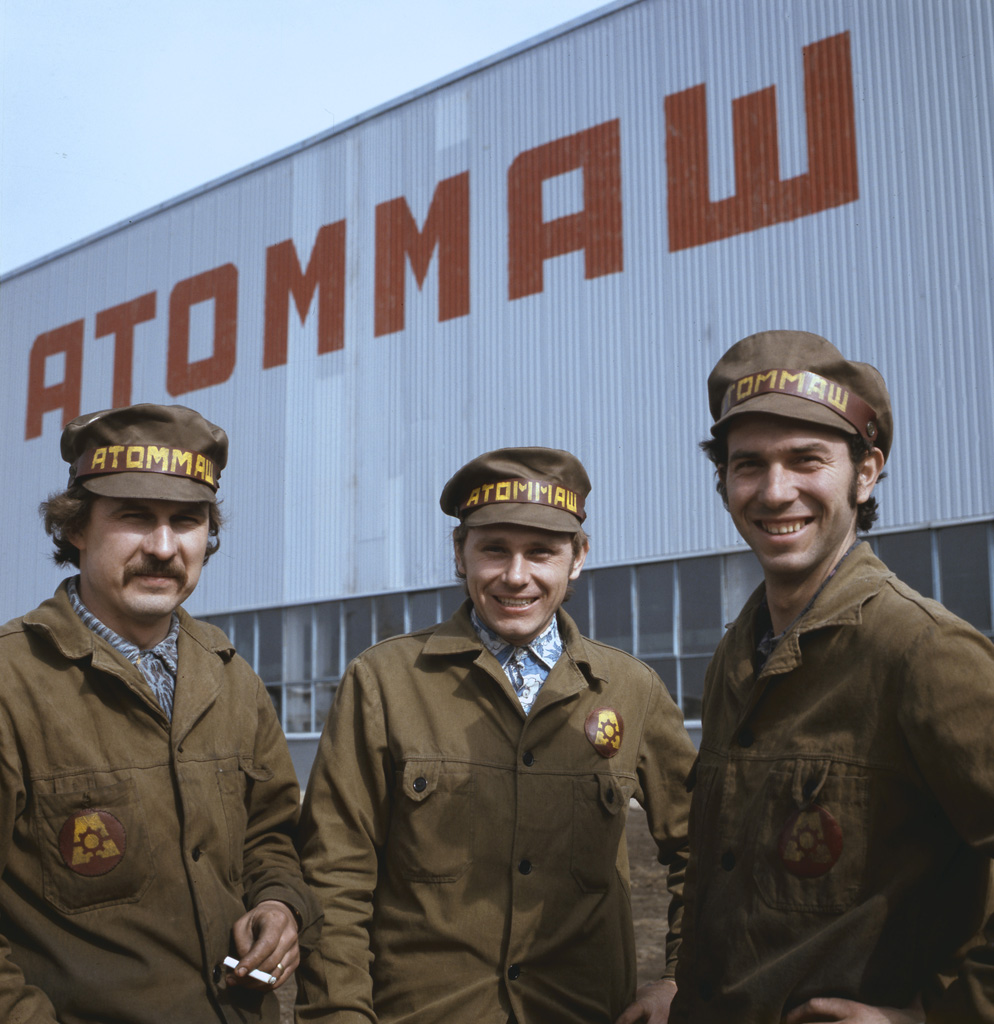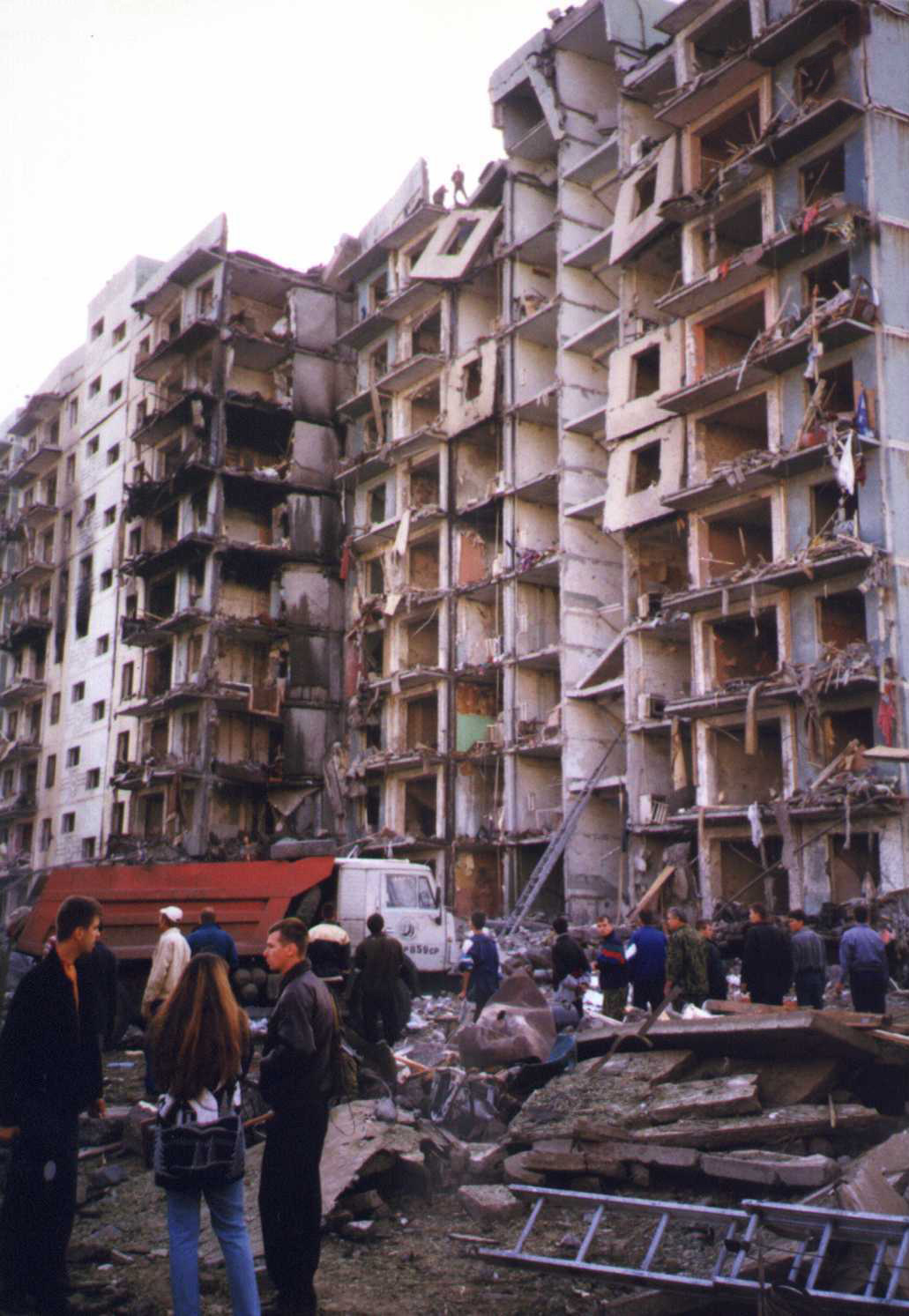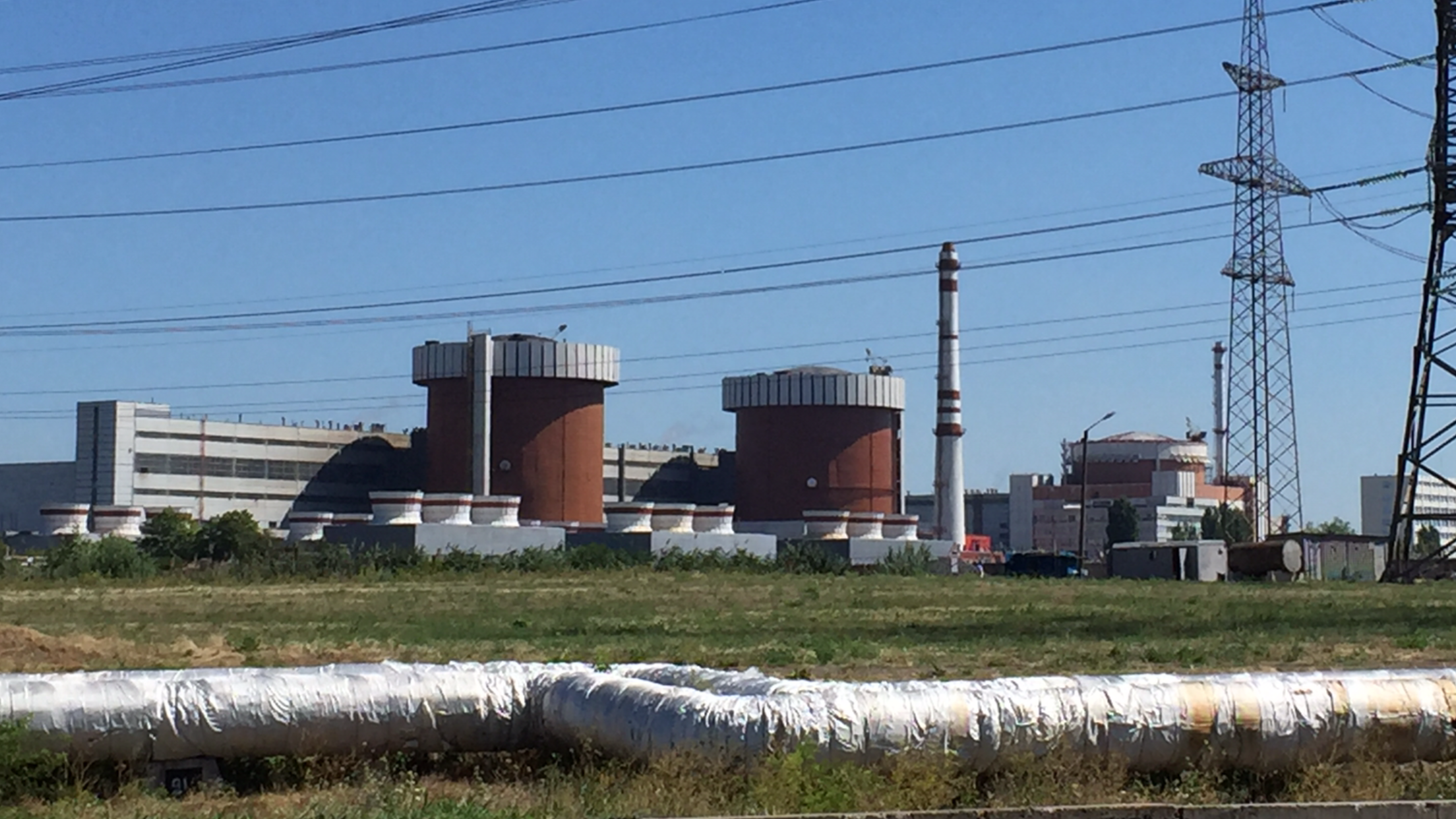|
Atommash
Atommash (russian: «Атоммаш») is a multidisciplinary engineering company located in Volgodonsk, Rostov Oblast, Russia. It was established in 1976 as a nuclear engineering corporation. Following privatization and bankruptcy in 1999, the industrial facilities of the enterprise were owned and managed by ZAO Energomash–Atommash, a part of the diversified engineering company Energomash. Since 2015 the company has been part of Atomenergomash, the mechanical engineering division of Rosatom. Its current name is "AEM-technology" JSC "Atommash" branch in Volgodonsk. History Soviet period: 1975-1991 On May 22, 1970, a state committee for the construction of the plant was assembled. On July 8, 1972, official hiring process for workers and engineers started. On August 30, 1975, the first stilt of the Production Facility #1 was erected. In 1973, the Politburo of the Central Committee of the Communist Party of the Soviet Union made a decision to establish a major nuclear eng ... [...More Info...] [...Related Items...] OR: [Wikipedia] [Google] [Baidu] |
Volgodonsk
Volgodonsk ( rus, Волгодонск, p=vəlgɐˈdonsk) is a city in Rostov Oblast, Russia, located in the east of the oblast on the west bank of the Tsimlyansk Reservoir. Population: 28,000 (1970). History Volgodonsk was founded in 1950 as a small settlement for the Tsimlyansk hydroelectric dam maintenance personnel. It grew in size due to the construction of the Volga–Don Canal. On September 16, 1999 a powerful truck bomb exploded outside an apartment building, killing 17 people and injuring a further 69. It was the fifth explosion in a series of apartment bombings in Russia that killed more than 300 people. Administrative and municipal status Within the framework of administrative divisions, it is incorporated as Volgodonsk Urban Okrug—an administrative unit with the status equal to that of the districts.Law #340-ZS As a municipal division, this administrative unit also has urban okrug status.Law #186-ZS Economy Volgodonsk is one of the economic leaders of Ros ... [...More Info...] [...Related Items...] OR: [Wikipedia] [Google] [Baidu] |
Atomenergomash
Atomenergomash (AEM) (russian: Атомэнергомаш) is a power engineering Russian company. Аtomenergomash JSC (AEM Holding company, AEM, Group) is a Russian power engineering company, a supplier of products for nuclear and thermal power plants, natural gas and petrochemical industry, shipbuilding, and special steel markets. It is the nuclear power division of Rosatom. Together with its subsidiaries it employees more than 17,000 people. History AEM was established in 2006 as part of Rosatom State Atomic Energy Corporation. Operations Atomenergomash is the largest power engineering holdings in Russia, that offers a full range of solutions in the areas of design, manufacture, and supply of equipment for nuclear and thermal energy, gas and petrochemical, shipbuilding industries, and the market of special steels. Structure Atomenergomash incorporates the following companies: * TSNIITMASH * OKB Gidropress * OKBM Afrikantov * AEM-Technologies * CKMB * Energomashspe ... [...More Info...] [...Related Items...] OR: [Wikipedia] [Google] [Baidu] |
Black Sea
The Black Sea is a marginal mediterranean sea of the Atlantic Ocean lying between Europe and Asia, east of the Balkans, south of the East European Plain, west of the Caucasus, and north of Anatolia. It is bounded by Bulgaria, Georgia, Romania, Russia, Turkey, and Ukraine. The Black Sea is supplied by major rivers, principally the Danube, Dnieper, and Don. Consequently, while six countries have a coastline on the sea, its drainage basin includes parts of 24 countries in Europe. The Black Sea covers (not including the Sea of Azov), has a maximum depth of , and a volume of . Most of its coasts ascend rapidly. These rises are the Pontic Mountains to the south, bar the southwest-facing peninsulas, the Caucasus Mountains to the east, and the Crimean Mountains to the mid-north. In the west, the coast is generally small floodplains below foothills such as the Strandzha; Cape Emine, a dwindling of the east end of the Balkan Mountains; and the Dobruja Plateau considerably ... [...More Info...] [...Related Items...] OR: [Wikipedia] [Google] [Baidu] |
Order Of The Government Of Russia
Orders of the Government of Russia (russian: Постановления и Pаспоряжения) is secondary legislation, a normative administrative directive content published by the Government of the Russian Federation within the limits of its competence, on the basis and in pursuance of the Constitution of the Russian Federation, federal constitutional laws, federal laws and Decrees of the President of Russia. Legal basis Government orders signed by the Prime Minister of Russia The chairman of the government of the Russian Federation, also informally known as the prime minister, is the nominal head of government of Russia. Although the post dates back to 1905, its current form was established on 12 December 1993 fo .... Government orders are binding in the Russian Federation. In the event of conflict with the Constitution of the Russian Federation, federal laws and decrees of the President, government orders may be revoked by the President of Russia. order of th ... [...More Info...] [...Related Items...] OR: [Wikipedia] [Google] [Baidu] |
Dissolution Of The Soviet Union
The dissolution of the Soviet Union, also negatively connoted as rus, Разва́л Сове́тского Сою́за, r=Razvál Sovétskogo Soyúza, ''Ruining of the Soviet Union''. was the process of internal disintegration within the Soviet Union (USSR) which resulted in the end of the country's and its federal government's existence as a sovereign state, thereby resulting in its constituent republics gaining full sovereignty on 26 December 1991. It brought an end to General Secretary Mikhail Gorbachev's (later also President) effort to reform the Soviet political and economic system in an attempt to stop a period of political stalemate and economic backslide. The Soviet Union had experienced internal stagnation and ethnic separatism. Although highly centralized until its final years, the country was made up of fifteen top-level republics that served as homelands for different ethnicities. By late 1991, amid a catastrophic political crisis, with several republics alr ... [...More Info...] [...Related Items...] OR: [Wikipedia] [Google] [Baidu] |
Chernobyl Disaster
The Chernobyl disaster was a nuclear accident that occurred on 26 April 1986 at the No. 4 reactor in the Chernobyl Nuclear Power Plant, near the city of Pripyat in the north of the Ukrainian SSR in the Soviet Union. It is one of only two nuclear energy accidents rated at seven—the maximum severity—on the International Nuclear Event Scale, the other being the 2011 Fukushima nuclear disaster in Japan. The initial emergency response, together with later decontamination of the environment, involved more than 500,000 personnel and cost an estimated 18 billion roubles—roughly US$68 billion in 2019, adjusted for inflation. The accident occurred during a safety test meant to measure the ability of the steam turbine to power the emergency feedwater pumps of an RBMK-type nuclear reactor in the event of a simultaneous loss of external power and major coolant leak. During a planned decrease of reactor power in preparation for the test, the operators accidentally drop ... [...More Info...] [...Related Items...] OR: [Wikipedia] [Google] [Baidu] |
Hospital
A hospital is a health care institution providing patient treatment with specialized health science and auxiliary healthcare staff and medical equipment. The best-known type of hospital is the general hospital, which typically has an emergency department to treat urgent health problems ranging from fire and accident victims to a sudden illness. A district hospital typically is the major health care facility in its region, with many beds for intensive care and additional beds for patients who need long-term care. Specialized hospitals include trauma centers, rehabilitation hospitals, children's hospitals, seniors' (geriatric) hospitals, and hospitals for dealing with specific medical needs such as psychiatric treatment (see psychiatric hospital) and certain disease categories. Specialized hospitals can help reduce health care costs compared to general hospitals. Hospitals are classified as general, specialty, or government depending on the sources of income received. A teac ... [...More Info...] [...Related Items...] OR: [Wikipedia] [Google] [Baidu] |
School
A school is an educational institution designed to provide learning spaces and learning environments for the teaching of students under the direction of teachers. Most countries have systems of formal education, which is sometimes compulsory. In these systems, students progress through a series of schools. The names for these schools vary by country (discussed in the '' Regional terms'' section below) but generally include primary school for young children and secondary school for teenagers who have completed primary education. An institution where higher education is taught is commonly called a university college or university. In addition to these core schools, students in a given country may also attend schools before and after primary (elementary in the U.S.) and secondary (middle school in the U.S.) education. Kindergarten or preschool provide some schooling to very young children (typically ages 3–5). University, vocational school, college or seminary ... [...More Info...] [...Related Items...] OR: [Wikipedia] [Google] [Baidu] |
Kindergarten
Kindergarten is a preschool educational approach based on playing, singing, practical activities such as drawing, and social interaction as part of the transition from home to school. Such institutions were originally made in the late 18th century in Germany, Bavaria and Alsace to serve children whose parents both worked outside home. The term was coined by German pedagogue Friedrich Fröbel, whose approach globally influenced early-years education. Today, the term is used in many countries to describe a variety of educational institutions and learning spaces for children ranging from 2 to 6 years of age, based on a variety of teaching methods. History Early years and development In 1779, Johann Friedrich Oberlin and Louise Scheppler founded in Strasbourg an early establishment for caring for and educating preschool children whose parents were absent during the day. At about the same time, in 1780, similar infant establishments were created in Bavaria. In 1802, Princ ... [...More Info...] [...Related Items...] OR: [Wikipedia] [Google] [Baidu] |
Nursery School
A preschool, also known as nursery school, pre-primary school, or play school or creche, is an educational establishment or learning space offering early childhood education to children before they begin compulsory education at primary school. It may be publicly or privately operated, and may be subsidized from public funds. Information Terminology varies by country. In some European countries the term "kindergarten" refers to formal education of children classified as '' ISCED level 0'' – with one or several years of such education being compulsory – before children start primary school at ''ISCED level 1''. The following terms may be used for educational institutions for this age group: *Pre-Primary or Creche from 6 weeks old to 6 years old- is an educational childcare service a parent can enroll their child(ren) in before primary school. This can also be used to define services for children younger than kindergarten age, especially in countries where kindergarten is ... [...More Info...] [...Related Items...] OR: [Wikipedia] [Google] [Baidu] |
South Ukraine Nuclear Power Plant
The South Ukraine Nuclear Power Plant ( uk, Південноукраїнська АЕС), also known as the Pivdennoukrainsk Nuclear Power Plant, is a nuclear power plant in Ukraine, near the city of Yuzhnoukrainsk in Mykolaiv Oblast, about south of Kyiv. It is the second largest of the country's five nuclear power stations. It is part of the South Ukrainian Energy Complex, along with the Tashlyk Pumped-Storage Power Plant and Oleksandrivska hydroelectric power station. It has three VVER-1000 pressurized water reactors and a net generation capacity of 2,850 megawatts (MW). In 2013, following major upgrade work, unit 1 was given a 10-year license extension, which will take it beyond its original 30-year design lifetime. Similar extensions are planned for units 2 and 3, licensed until 2015 and 2019, respectively. The Vetrino–Isaccea–Yuzhnoukrainsk powerline runs from the plant to Isaccea, Romania, but is mostly dismantled or ruined. According to Ukraine, Russian troops ... [...More Info...] [...Related Items...] OR: [Wikipedia] [Google] [Baidu] |
Council Of Ministers (Soviet Union)
The Council of Ministers of the Union of Soviet Socialist Republics ( rus, Совет министров СССР, r=Sovet Ministrov SSSR, p=sɐˈvʲet mʲɪˈnʲistrəf ɛsɛsɛˈsɛr; sometimes abbreviated to ''Sovmin'' or referred to as the ''Soviet of Ministers''), was the ''de jure'' government of the Union of Soviet Socialist Republics (USSR), comprising the main executive and administrative agency of the USSR from 1946 until 1991. During 1946 the Council of People's Commissars was reorganized as the Council of Ministers. Accordingly, the People's Commissariats were renamed as Ministries. The council issued declarations and instructions based on and in accordance with applicable laws, which had obligatory jurisdictional power in all republics of the Union. However, the most important decisions were made by joint declarations with the Central Committee of the Communist Party of Soviet Union (CPSU), which was ''de facto'' more powerful than the Council of Ministers. During ... [...More Info...] [...Related Items...] OR: [Wikipedia] [Google] [Baidu] |



.jpg)


.jpg)

